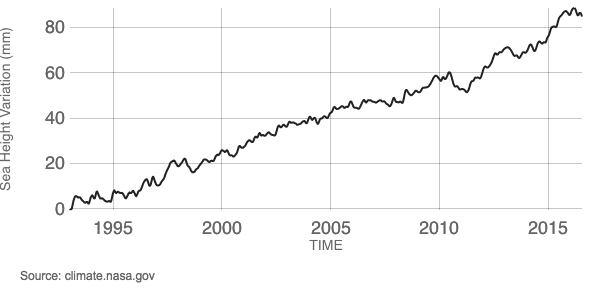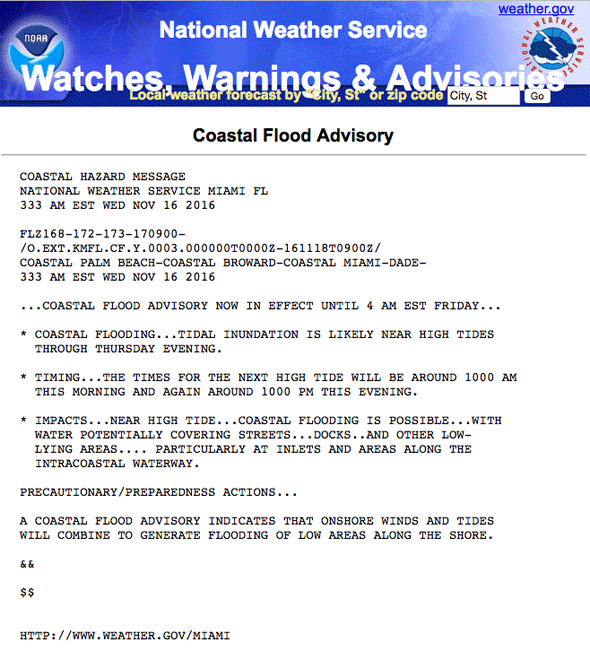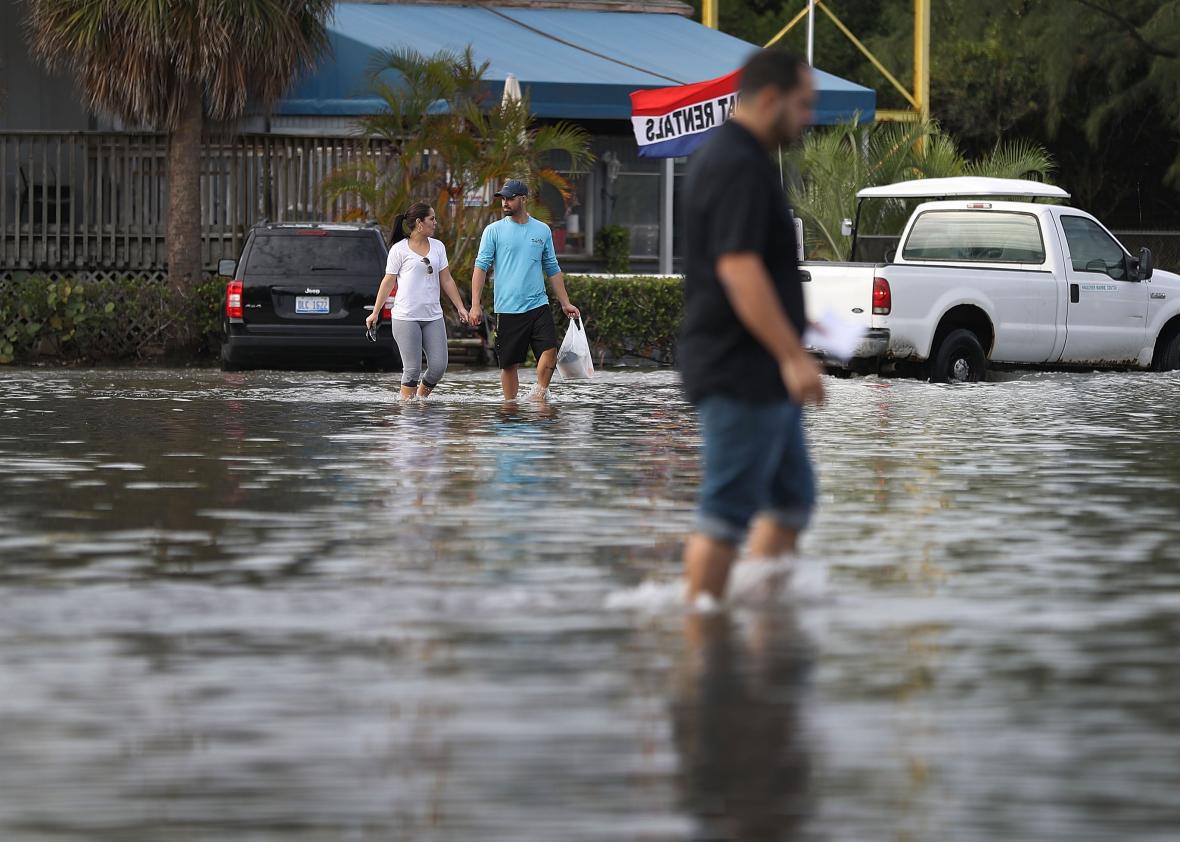There is one real thing about the “Supermoon”: It causes flooding. But it needs help in the form of global warming.
I wrote about the so-called “Supermoon” on Monday. The basic idea is that we get a “Suupermoon” when the Moon is full at the same time it’s also at its closest point to Earth in its orbit. According to the lore, the Moon will look bigger and be brighter.
While technically true, these claims tend to be overhyped and breathless, leaving people thinking they’ll see a ginormous Moon in the sky. That’s not the case; as I point out in the article earlier this week the “Supermoon” is only about 10 percent closer than it is when it’s at apogee (the farthest point in its orbit from Earth). You’d never notice the difference in size unless you measure it. It does get brighter, by about 20 - 30 percent, which again is tough to notice on your own.
But there is one thing I didn’t mention in that article, and this is a very real and potentially disastrous effect: Tides.
Time and Tides
Tides are complicated. How they work has been argued for centuries (Newton tackled them back in the 1600s!), but in the end it has to do with the way gravity works. I go over this in detail in my episode of Crash Course Astronomy: Tides:
Here’s a quick overview: The strength of gravity weakens with distance, so the Moon’s gravity pulls harder on the near side of the Earth closer to the Moon than the far side. This stretches the Earth a bit, making it somewhat egg-shaped. Measured from the center of the Earth, both the near and far side of the Earth bump outward a bit, pulled up by the Moon’s gravity. The way gravity works, these are places of lower gravitational potential, so fluids will flow in those directions. Water is a fluid, so it flows to these points, creating high tides, one at each “end” of the Earth. That’s why we get two high tides per day; the Earth’s rotation sweeps you past these two high tide points every day.
During a “Supermoon”, the Moon is closer to Earth. Its apparent size in the sky grows as distance shrinks — make the Moon 10 percent closer and it looks 10 percent bigger. Its brightness grows as the inverse square of the distance — make it 10 percent closer and it looks 1.1 x 1.1 = 1.21 = ~20 percent brighter.
But tides work with the cube of distance, so if the Moon is 10 percent closer the tides are 1.1 x 1.1 x 1.1 = 30 percent higher than when the Moon is farther away. The higher high tides we get when the Moon is close are called proxigean tides, and they happen every month. The unusually close Moon on Nov. 14 meant they were somewhat higher than normal, even for regular proxigean tides.
But there’s more. The Sun creates tides on the Earth, too. It’s far more massive than the Moon, but much farther away, so in the end contributes about half as much to the tides on Earth as the Moon does. When the Moon and Sun are in a line these forces all add up, creating even higher high tides (and lower low tides) than usual. We call these “spring tides”, and they happen twice a month, when the Moon is full and when it’s new.
So the “Supermoon” pulled a double whammy: It was closer than usual, and full, so tides were especially high earlier in the week. We had, and still this week are still having, proxigean spring tides.
The Rising Seas
If things were normal, that would be bad enough. Coastal areas prone to flooding see higher tides twice a month due to spring tides, and also higher tides once a month from the proxigean tides. When they line up it’s worse, but generally not catastrophic.
Unless, that is, a third force comes along. For example, if this happens when there’s a storm, off shore, things can get very bad. Low-pressure systems (like hurricanes or just big storms) draw water toward their centers. If one comes ashore, this can create a storm surge, inundating low-lying areas.
But there’s yet another factor here, and it’s the most pernicious of all: sea level rise.
Global warming is melting ice at the poles (yes, at both poles), and also causing water in the oceans to expand. This is causing the sea levels to rise up over time, by about three millimeters per year. That may not sound like much, but it adds up, year after year. It’s risen 85 mm — over three inches — just since 1993!

NASA / Goddard Space Flight Center
As Tamino points out at the Open Mind blog, this alone is enough to cause flooding in coastal areas like Miami and Boston during a normal high tide.
Proxigean tides aren’t normal; they are extra strong. That’s why the NOAA issued a coastal flood warning not just for Monday but for this whole week up until tonight. It’s not until then that the Moon moves away enough both from the Earth and the Earth/Sun line to weaken tides sufficiently to relent on flooding.
But there was flooding, in Portland, Maine, Charleston, South Carolina, and many other locations. From what I can find it was bad but not devastating. It’s what Tamino calls nuisance flooding, and — pardon the expression — it’s on the rise.
In other words, and to be very clear: Global warming is causing sea level rise, which is causing more flooding all the time, and it will get worse. A lot worse.

NOAA
Remember the “superstorm” Sandy that hit New York City in 2012? It caused huge amounts of damage to flooding, and was itself linked to climate change. It also happened during a full Moon, when tides were worse. Every millimeter of sea level was important there; had it been a proxigean tide as well damage would have been even worse. As it was, it was near apogee (about 400,000 km away) so at least in that sense the effect was minimized. But sea level rise played a critical role there in the flooding.
Moon with a View
I’ve been saying the Supermoon is almost all hype, exaggerated by media. But in this case it really does have an effect, and nature itself will amplify it more and more, year by year. Global warming is making that inevitable.
I cannot end this without stating the glaringly obvious, and doing so bluntly as well: The election of Donald Trump as President is and will be an epic disaster. I mean that literally. With a Republican President who is demonstrably easy to influence, cabinet choices that are the height of assininery, and a Republican Congress all too willing to deny global warming and obstruct any and all attempts to do anything to mitigate it, we are facing a threat to our national security, our nation, and our way of existence. Every year, every month we wait to take action, has huge ramifications down the road.
That is not hype. That’s cold, hard fact. Still, as my Slate colleague Eric Holthaus points out, not all is lost, and there’s much we can do.
It’s up to all of us to stay vigilant, and to act as resistance to the denial of reality by the GOP. We have just been handed a big setback, and one with global ramifications, but — hopefully — it won’t be forever.
